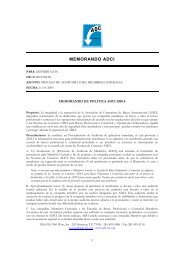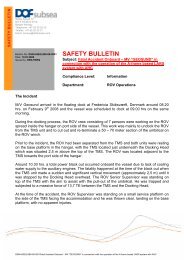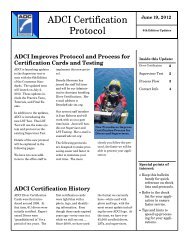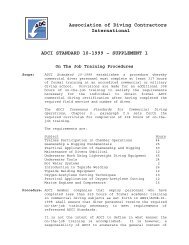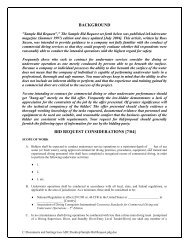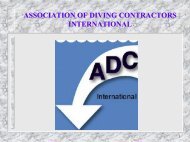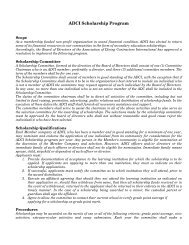DIRECTIVE NUMBER: CPL 02-00-151 EFFECTIVE DATE ... - OSHA
DIRECTIVE NUMBER: CPL 02-00-151 EFFECTIVE DATE ... - OSHA
DIRECTIVE NUMBER: CPL 02-00-151 EFFECTIVE DATE ... - OSHA
You also want an ePaper? Increase the reach of your titles
YUMPU automatically turns print PDFs into web optimized ePapers that Google loves.
exits the water.<br />
(2) A device shall be used which minimizes the possibility of<br />
entanglement of the diver’s hose in the propeller of the vessel.<br />
(3) Two-way voice communication between the designated person-incharge<br />
and the person controlling the vessel shall be available while the<br />
diver is in the water.<br />
(4) A standby diver shall be available while a diver is in the water.<br />
(5) A diver-carried reserve breathing-gas supply shall be carried by each<br />
diver engaged in liveboating operations.<br />
1910.430 EQUIPMENT. Comments/Remarks/Notes<br />
(a) General.<br />
(1) All employers shall comply with the following requirements, unless<br />
otherwise specified.<br />
(2) Each equipment modification, repair, test, calibration or maintenance<br />
service shall be recorded by means of a tagging or logging system, and<br />
include the date and nature of work performed, and the name or initials<br />
of the person performing the work.<br />
(b) Air compressor system.<br />
(1) Compressors used to supply air to the diver shall be equipped with a<br />
volume tank with a check valve on the inlet side, a pressure gauge, a<br />
relief valve, and a drain valve.<br />
(2) Air compressor intakes shall be located away from areas containing<br />
exhaust or other contaminants.<br />
(3) Respirable air supplied to a diver shall not contain:<br />
(i) A level of carbon monoxide (CO) greater than 20 ppm;<br />
(ii) A level of carbon dioxide (CO 2 ) greater than 1,<strong>00</strong>0 ppm;<br />
(iii) A level of oil mist greater than 5 milligrams per cubic meter; or<br />
(iv) A noxious or pronounced odor.<br />
(4) The output of air compressor systems shall be tested for air purity<br />
every 6 months by means of samples taken at the connection to the<br />
distribution system, except that non-oil lubricated compressors need not<br />
be tested for oil mist.<br />
(c) Breathing-gas supply hoses.<br />
(1) Breathing-gas supply hoses shall:<br />
(i) Have a working pressure at least equal to the working pressure of<br />
the total breathing-gas system;<br />
(ii) Have a rated bursting pressure at least equal to 4 times the working<br />
pressure;<br />
(iii) Be tested at least annually to 1.5 times their working pressure; and<br />
(iv) Have their open ends taped, capped or plugged when not in use.<br />
(2) Breathing-gas supply hose connectors shall:<br />
(i) Be made of corrosion-resistant materials;<br />
(ii) Have a working pressure at least equal to the working pressure of the<br />
hose to which they are attached; and<br />
(iii) Be resistant to accidental disengagement.<br />
(3) Umbilicals shall:<br />
(i) Be marked in 10-foot increments to 1<strong>00</strong> feet beginning at the diver’s<br />
end, and in 50-foot increments thereafter;<br />
(ii) Be made of kink-resistant materials; and<br />
(iii) Have a working pressure greater than the pressure equivalent to the<br />
maximum depth of the dive (relative to the supply source) plus 1<strong>00</strong> psi.<br />
(d) Buoyancy control.<br />
(1) Helmets or masks connected directly to the dry suit or other<br />
I-8


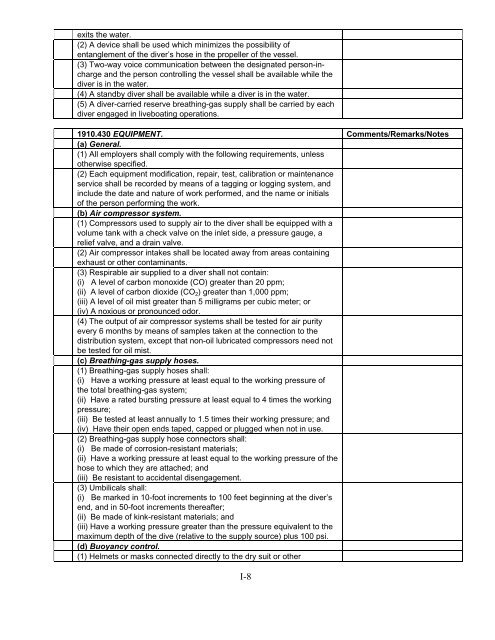
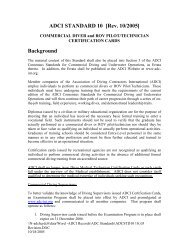
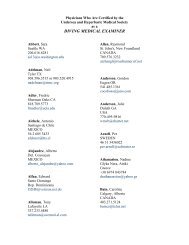
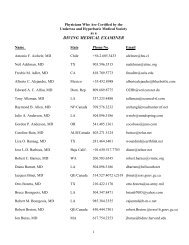
![SOLICITUD MEMBRESIA ASOCIADO [Rev 06/08] - Association of ...](https://img.yumpu.com/48291988/1/190x245/solicitud-membresia-asociado-rev-06-08-association-of-.jpg?quality=85)

